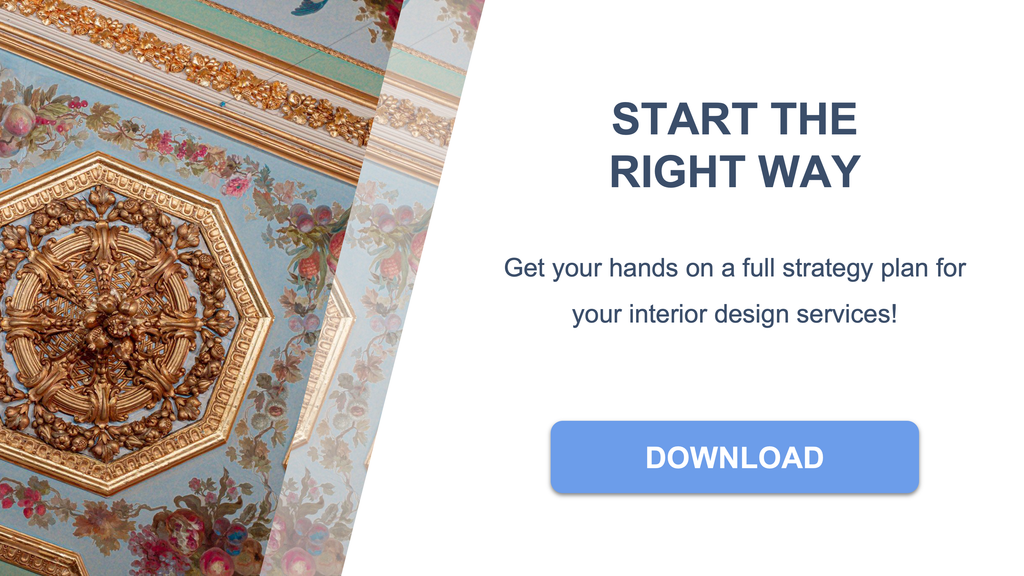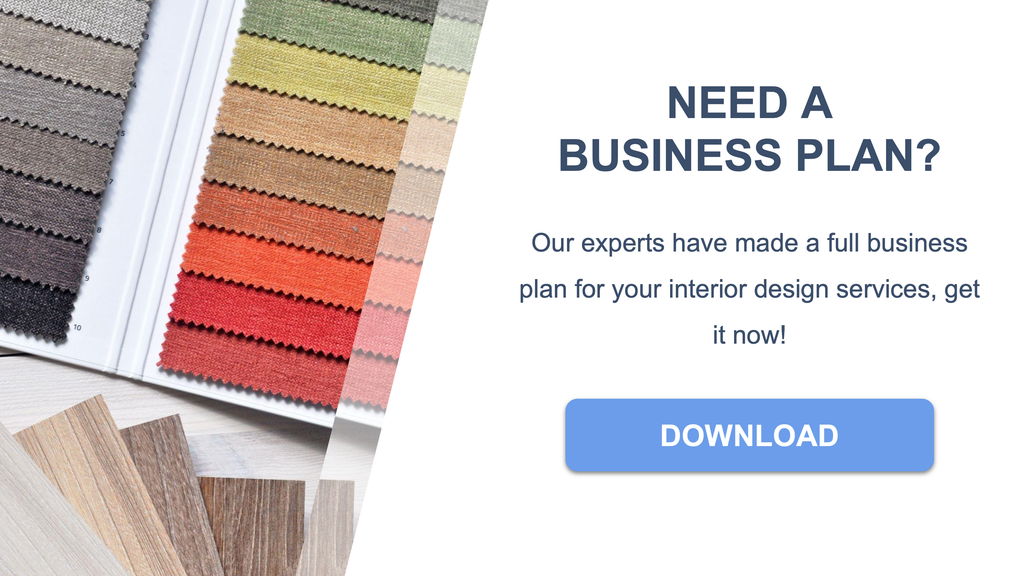
Get a watermark-free, fully customizable business model canvas in our business plan for an interior design services
In the dynamic realm of interior design, having a clear and innovative approach is essential to captivate clients and thrive.
Welcome to your detailed walkthrough of the Business Model Canvas, customized for interior design professionals.
This piece dissects the framework into manageable sections, enabling you to pinpoint your unique value proposition, target clientele, core activities, and beyond.
Should you be in search of a ready-to-use Business Model Canvas that's fully customizable, feel free to explore our business plan template designed for interior design ventures.
What is a Business Model Canvas? Should you make one for your interior design services?
A Business Model Canvas is a strategic tool designed to help you map out the key components of your interior design service business. It's a visual framework that lays out how you plan to create, deliver, and capture value in the interior design industry.
Think of it as a blueprint that captures your business strategy on a single page, highlighting your unique value proposition, customer segments, channels, customer relationships, revenue streams, key resources, key activities, key partnerships, and cost structure.
Why do people create a Business Model Canvas? For interior designers, it's about gaining clarity on your business model. It helps you understand how you'll stand out in the market, the kind of clients you want to attract, the services you'll offer, and how you'll manage the financial aspects of your business.
For example, you might detail your approach to sustainable design, your partnerships with local artisans, your marketing strategies, and how you plan to price your services.
The benefits are clear and practical.
Firstly, it encourages strategic thinking and helps you focus on the core aspects of your business. It can reveal potential challenges or opportunities, allowing you to refine your approach before fully committing to it.
For instance, you may discover that your initial plan to target luxury clients is not as viable as offering affordable design packages that appeal to a broader market. Such insights can be invaluable, saving you time and money.
Should you create one if you're starting a new interior design project? Definitely.
It's an essential part of the planning process that can steer your decisions and strategies. It enables you to communicate your vision to potential investors, partners, or employees in a clear and concise manner. A well-thought-out Business Model Canvas, similar to what you might find in our business plan template tailored for interior design services, can transform a vague idea into a concept with a clear strategic direction.
Is it useful for you? Absolutely, especially if you aim to establish a well-defined plan for your interior design business. It compels you to systematically think through your business model and assess the viability of your service offerings.
Moreover, it's a dynamic document that you can revise as your business evolves or as the market landscape shifts.

How to create a Business Model Canvas for your interior design services?
Designing a Business Model Canvas for your interior design services should be straightforward.
You can simply modify the one we have already created and filled in our business plan template tailored for interior design services.
Need more guidance? Let's deconstruct it into digestible sections, focusing on each part of the canvas. We'll walk you through how to complete it with relevant ideas and inspiration, using a clear and concise method.
Value Proposition
Let's start with the Value Proposition.
This is the core of your interior design business. What sets your services apart? Is it your innovative design concepts, personalized customer service, or perhaps your sustainability practices?
Consider what will compel clients to choose your services over competitors.
It might be your expertise in a specific design style, a unique process that involves clients in every step, or exclusive access to certain high-quality materials.
Customer Segments
Moving on to Customer Segments.
Who are your clients? Are you catering to homeowners looking to renovate, real estate developers seeking to attract buyers, or businesses wanting to revamp their office space?
Knowing your target audience will influence many of your business choices, from the services you offer to your marketing approach.
Channels
Now, let's consider Channels.
How will you connect with your clients? This may include a combination of digital and traditional methods.
Think about leveraging social media for showcasing your portfolio, a professional website for inquiries and consultations, and networking events to meet potential clients.
Remember the importance of referrals and think about how you can motivate clients to recommend your services.
Customer Relationships
Customer Relationships are about how you engage with your clients and ensure their satisfaction.
Outstanding communication, follow-up services, and responding to client feedback are crucial.
Consider how you can use technology to improve client interaction, such as through virtual design tools or a client portal for project updates.
Revenue Streams
In the Revenue Streams section, you'll reflect on how your interior design business will generate income.
Beyond individual projects, consider other sources of revenue like design consulting, selling custom furniture or decor, or offering online design courses.
Be inventive and think about what aligns with your brand and client base.
Key Activities
On the flip side of the canvas, we have Key Activities.
These are the critical tasks you need to perform to run your interior design business. This includes client consultations, design planning, project management, and staying updated with design trends.
Identify the activities that are essential to delivering your value proposition and how you can carry them out effectively.
Key Resources
Key Resources are the assets vital to your value proposition.
This encompasses your design software, your team, your network of suppliers, and your portfolio. Reflect on what you need to excel in your business and how you can obtain these resources.
Key Partnerships
Key Partnerships could involve collaborations with architects, contractors, or suppliers that can help you streamline processes or offer exclusive materials.
For example, partnering with a home staging company or a real estate firm could provide a steady stream of clients.
Cost Structure
Finally, Cost Structure.
Running an interior design business entails various expenses, from software subscriptions and employee salaries to marketing and travel costs. Understanding these will aid in managing your finances effectively.
It's crucial to distinguish which costs are fixed, such as software licenses, and which are variable, like project-specific materials, to budget wisely.
What should be included in each section of the Business Model Canvas for an interior design services?
Unsure about how to tailor the Business Model Canvas for your interior design services? You can start by modifying the template we've included in our business plan template.
Let us guide you through some examples of what you might include in each section of the Business Model Canvas for an interior design business.
| Component | Examples |
|---|---|
| Key Partners | Furniture suppliers, Contractors, Real estate agencies, Architectural firms, Art dealers |
| Key Activities | Design consultation, Project management, Space planning, Client presentations, Trend research |
| Key Resources | Design software, Portfolio of past work, Showroom or studio space, Professional design team, Industry network |
| Value Propositions | Customized design solutions, Expertise in sustainable materials, Access to exclusive furnishings, 3D visualization of spaces, Post-project support |
| Customer Relationships | One-on-one design consultations, Follow-up services, Client workshops, Online project updates, Responsive customer service |
| Channels | Company website, Social media profiles, Interior design trade shows, Referral programs, Design workshops |
| Customer Segments | Homeowners, Commercial businesses, Property developers, Boutique hotels, Interior design enthusiasts |
| Cost Structure | Design team salaries, Software subscriptions, Marketing and branding expenses, Studio rent, Sample materials |
| Revenue Streams | Design consulting fees, Project management charges, Commission on products, Design workshops, Speaking engagements |

Examples of Business Model Canvas for an interior design services
Below are examples of business model canvases for three different types of interior design services: Residential Interior Design Firm, Commercial Interior Design Consultancy, and Online Interior Design Platform.
Residential Interior Design Firm Business Model Canvas
| Component | Description |
|---|---|
| Key Partners | Furniture suppliers, contractors, real estate agents, architects |
| Key Activities | Design consultations, project management, space planning, client presentations |
| Value Propositions | Personalized design solutions, high-quality materials, attention to detail, turnkey projects |
| Customer Relationships | One-on-one consultations, after-service follow-up, referral incentives |
| Customer Segments | Homeowners, new home buyers, individuals seeking luxury designs |
| Key Resources | Design team, portfolio, design software, showroom |
| Channels | Word-of-mouth, social media, home design expos, website |
| Cost Structure | Staff salaries, marketing, showroom maintenance, design tools |
| Revenue Streams | Design fees, project management fees, commissions from suppliers |
Commercial Interior Design Consultancy Business Model Canvas
| Component | Description |
|---|---|
| Key Partners | Commercial builders, office furniture vendors, lighting suppliers, corporate clients |
| Key Activities | Corporate space design, ergonomic assessments, brand integration, sustainability consulting |
| Value Propositions | Enhanced workplace functionality, brand-aligned interiors, sustainable design practices |
| Customer Relationships | Long-term partnerships, project updates, professional networking |
| Customer Segments | Businesses, healthcare facilities, educational institutions, hospitality industry |
| Key Resources | Experienced consultants, industry contacts, certifications, design portfolio |
| Channels | Industry events, LinkedIn, B2B networking, trade publications |
| Cost Structure | Consultant fees, travel expenses, marketing, professional development |
| Revenue Streams | Consulting fees, retainer contracts, speaking engagements |
Online Interior Design Platform Business Model Canvas
| Component | Description |
|---|---|
| Key Partners | Technology providers, furniture and decor e-tailers, affiliate marketing partners |
| Key Activities | Platform development, user experience design, digital marketing, customer support |
| Value Propositions | Affordable design services, convenient online process, access to a wide range of products |
| Customer Relationships | Automated service with personal touch, user community, online support |
| Customer Segments | DIY decorators, budget-conscious clients, tech-savvy individuals |
| Key Resources | Design software, user interface, customer database, social proof |
| Channels | Website, social media, email marketing, online ads |
| Cost Structure | Platform maintenance, software licensing, customer acquisition |
| Revenue Streams | Service fees, affiliate commissions, premium memberships |

You can also read our articles about:
- how to build a marketing strategy for your interior design services
- how to segment the customers of your interior design services
- how to make a competition study for your interior design services
- how to become an interior designer (guide)
